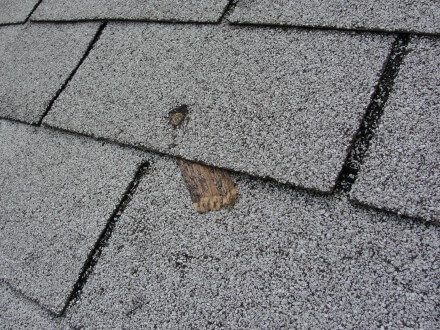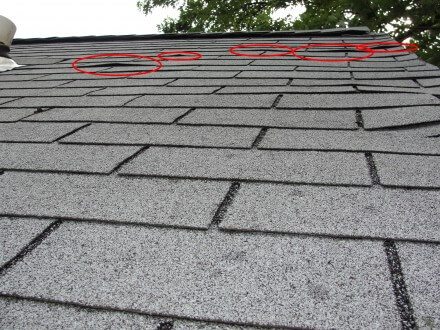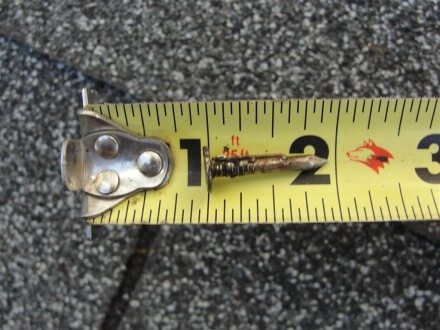Have you ever noticed roofs with shingles popping up all over the place? A common reason for this is the use of nails that are too short. When there are popped nails all over the roof, it might be the sign of a defective roof installation; specifically, short nails.
The minimum fastener length for an asphalt shingle roof in Minnesota is 1-1/4″. This requirement comes from section R905.2.5 of the 2006 International Residential Code, which is part of the Minnesota State Building Code. I underlined the part of this section that specifies the minimum fastener length.
R905.2.5 Fasteners. Fasteners for asphalt shingles shall be
galvanized steel, stainless steel, aluminum or copper roofing
nails, minimum 12 gage [0.105 inch (3 mm)] shank with
a minimum 3/8-inch (10 mm) diameter head, ASTM F 1667,
of a length to penetrate through the roofing materials and a
minimum of 3/4 inch (19 mm) into the roof sheathing. Where
the roof sheathing is less than 3/4 inch (19 mm) thick, the fasteners
shall penetrate through the sheathing. Fasteners shall
comply with ASTM F 1667.
In southern parts of the country where they don’t need to deal with snow loads, it’s acceptable to use 3/8″ roof sheathing, which means it’s also acceptable to use 1″ roofing nails on asphalt shingles. A 1″ nail will fully penetrate through 3/8″ roof sheathing, but it won’t fully penetrate 1/2″ sheathing. The diagram below helps to illustrate this.
When 1″ nails are used to fasten asphalt shingles to 1/2″ roof sheathing, only the very tip of the nail will penetrate the roof sheathing. Over time, expansion and contraction of the roof sheathing can force the nail back up and out of the roof. When this happens, the shingle tabs get lifted up. On three-tab shingles, these lifted areas are often visible from the ground.
To determine if the wrong nails were used, just pull out one of the popped nails. When 1″ nails are used, the nails have frequently worked themselves so far out of the sheathing that it doesn’t take much effort to pull the nail right of the roof by hand. If that doesn’t work, a pliers can usually be used to grab the head and pull the nail out without causing any damage to the shingle below.
The other way to determine if the proper nails were used is to look in the attic; if the roof has 1/2″ sheathing, you should be able to see the nails sticking through in to the attic. The photo below shows proper 1-1/4″ nails sticking through the roof sheathing on the attic side.
If all you can see is the very tip of the nails and you have 1/2″ sheathing, this is a problem. Of course, if the roof sheathing consists of 1″ roof boards, it’s acceptable for the nails to not penetrate the sheathing.
When too short of nails have been used at the shingles, it’s a defective roof installation that will be prone to popped nails and shingles coming loose. According to the roof gods in Minnesota, this is a common installation defect that happens with storm-chasing roof repair companies. You get a storm-chasing roofing crew that’s used to ‘southern’ rules for roofs, and they install the roof with 1″ shingles, just like they’re used to doing. The moral of the story is to avoid storm-chasing roof repair companies that go knocking door-to-door. Hire a reputable local company instead.
Once again, this is one of those defects that you shouldn’t expect the municipal (city) inspector to catch; they usually don’t walk on roofs, and they almost certainly won’t lift shingles to find nailing defects. If you have an especially savvy inspector, however, they might find a short nail or two laying in the gutter, which might prompt them to start asking more questions.
RELATED POST: Improper Shingle Nailing
Reuben Saltzman, Structure Tech Home Inspections










Roofing Contractors Houston
July 19, 2012, 6:41 am
Wow! That sure is a short nail. Most municipalities have a minimum of 1 1/4″ nail requirement.
Jack - Homeowner
June 5, 2013, 12:03 pm
In Tennessee this is common. Municipalities have codes, albeit, questionable in many cases. The counties have no real codes: the quote is we follow Southern Building Council Codes, can’t prove it by me. You hope and pray that you have a good contractor and have to watch every step or you’re cheated. The State does not truly protect the consumer! All learned by experience.
Brad
August 29, 2013, 8:31 am
finally, information that makes sense to the none roofer. I was looking for shorter nails to avoid the punch through, when all along punch through is the way to go.
well done.
mike
November 10, 2013, 10:54 am
Thanks for the article.
To others, never trust a building inspector. Courts have ruled many times that the government has no obligation to protect you. It’s up to the buyer to beware…
cj
November 16, 2013, 9:58 am
What size nail do you recommend if it is a finished tongue and groove ceiling on cape cod and you don’t want risk shooting through.
Reuben Saltzman
November 16, 2013, 9:49 pm
@cj – no insulation at the ceiling? I’ve never seen that. I suppose I’d use the longest nail possible that didn’t penetrate the sheathing.